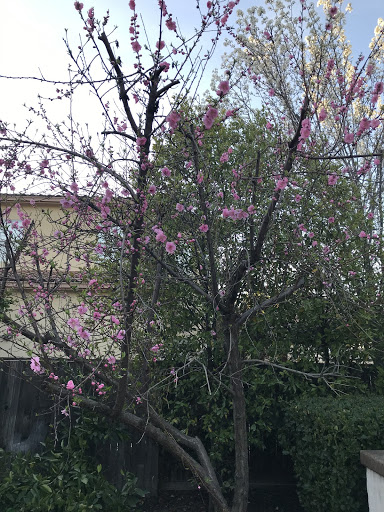
Take your mind off the problems for a moment, and focus on the positive possibilities. Consider how very much you are able to do. ~ Ralph Marston
Amidst the COVID-19 crisis our world is facing, and the accompanying anxiety and uncertainty, we are trying to remind ourselves of the many things big and small that we are grateful for. And one of those is that tomorrow is the first day of spring! The change in seasons brings new beginnings and a fresh start. Buds pop open, as pictured on Deb’s peach tree above. And each of those new buds eventually brings beautiful juicy peaches. So with the arrival of spring, we are reminded that no matter what the situation today, there remain new possibilities for the future.
We hope you find value and inspiration in our series focusing on words to jump-start solution-focused thinking and conversations. If you’re new to our blog, you can read more about our take on the power of word selection here. Last week’s word was “Strengths” – check out our perspective here.
Today’s word is POSSIBILITIES
In solution-focused talk, “possibilities” are interwoven with and build upon “strengths”, and what is working well. In theory, by doing “more” of what is “working”, there’s less time to dwell on things that are not going as well or as desired. Building upon strengths ultimately can create possibilities that you may not have even realized existed!
In a survey we conducted last year, we asked individuals living with diabetes about their experiences with diabetes education services. As we’ve shared before, many people (71% in our survey) are not satisfied with their experiences. Largely, traditional diabetes care and education services have employed a “problem-focused” approach that concentrates on trying to pin-point causes of “problems”. (What caused your low? Why haven’t you been exercising? What led to your time out of range? You get the idea…) Overwhelmingly, the survey respondents expressed desire for their healthcare professionals (HCPs) to focus on non-judgmental communication with individualized, personalized care and education. The desire is that HCPs be positive and express “You can be healthy and we’re here to support your journey!” Diabetes care and education specialists can play a key role in stepping alongside their clients with diabetes as think partners to envision possibilities.
THIS WEEK’S SOLUTION-FOCUSED CHALLENGE
Each week we’re including a solution-focused challenge that can help evolve care and education in a solution-focused manner. This week the challenge is to consider conversations around continuous glucose monitoring (CGM). The expansion of CGM technologies means more people can have access to more data and use that data to learn much more about their diabetes than what a single number shows. In fact, in the previously mentioned survey, when we asked people what they wanted to be doing “more of” in the future, multiple individuals responded with “more time-in-range.” Of course, no one wants to have glucose values that swing up and down or remain above or below target, yet many conversations (while well-meaning), are often focused on pinpointing the cause of the time out of range and the “whys”, when the cause is usually “diabetes”!
We’ve interpreted and applied learnings from the recent Advanced Technologies and Treatments for Diabetes meeting (ATTD) and presentation by renowned physician Dr. Rich Bergenstal to illustrate how to review CGM data using a solution-focused approach focused on possibilities and building upon strengths. (You can read the complete summary by diaTribe here.)
Here are 5 ways to evolve discussions around CGM:
- Flat, Narrow, In-Range (FNIR). When reviewing CGM trends, try using the FNIR approach, aiming for tracings that are flat, narrow, and in-range. It creates a goal and something that is possible with education, management, and support. More importantly, it steers clear of negative or disempowering terms while examining data.
- Steady, Tight And in-Range (STAR). Another approach similar to FNIR, again focusing on possibilities of tracings that are steady, tight, and in-range.
- More Green, Less Red (MGLR). Are you familiar with the Ambulatory Glucose Profile (AGP)? An AGP report is a standardized glucose report that includes summary statistics, a glucose profile graph and glucose daily calendar graphs. It provides a report format that is consistent regardless of blood glucose monitoring device. Graphs help translate the numbers into a picture for easy, quick interpretation. Try using MGLR particularly with the bar graph that indicates time-in-range. With this approach focus on the green can draw focus to strengths. What and how did you achieve the amount of green we see on the chart? How can you do more of that to see more green and less red? This approach can help build possibilities and define actions.
- Thinking fast and slow. What this means is thinking about readings in real time – when one would need to act fast (like responding to a CGM low alert), then taking some time to look at retrospective data and “think slow”, spending time learning to pinpoint strengths and more realistically think about possibilities.
- Best Day. Another solution-focused option that we’re fans of is the “Best Day” pattern feature on the AGP report. Focusing on what went well on the “best day” when their glucose values were more in range can guide the individual to focus on their strengths. Questions you could ask are, “What were you doing on this day to help you have more green and less red? What else was working for you?” This is also a good opportunity to practice “thinking slow” and encouraging individuals to spend time trying to learn from their CGM data.
So with the arrival of spring, just as Deb’s peach blossoms have the possibility of turning into sweet, juicy peaches as they did last year (pictured below), taking a solution-focused approach to diabetes care and education can be a fresh new start and bring possibilities to light..

We welcome anyone interested in our approach to Subscribe to our blog and we’ll email you when a new post is published!
If you are a health care professional and interested in learning more about our solution-focused practice and approach, when you subscribe to our blog, we’ll send you in return a FREE resource of 10 Solution-Focused Questions to start a solution-focused discussion with your clients.
Follow us on Twitter and Instagram @AFreshPOVforYou